Table of Contents
How to Make Natural Perfume at Home: Your Guide to Non-Toxic, DIY Fragrance
This page may contain affiliate links. We may earn a commission on purchases, at no additional cost to you. Learn more →
Want to smell amazing without exposing yourself to toxic chemicals? You're in the right place. If you've ever gotten a headache from conventional perfumes or wondered what's really in that "fragrance" ingredient list, making your own natural perfume might be the perfect solution for you and your family.
Here's the problem: Most commercial perfumes contain a cocktail of synthetic chemicals hidden under the single word "fragrance." According to the Environmental Working Group (EWG), the average fragrance product contains 14 undisclosed chemicals, including phthalates—endocrine disruptors linked to hormone interference and reproductive harm. That's particularly concerning if you're pregnant, nursing, or have young children at home.
Making your own perfume lets you avoid these hidden ingredients while creating a custom scent that reflects your personality.
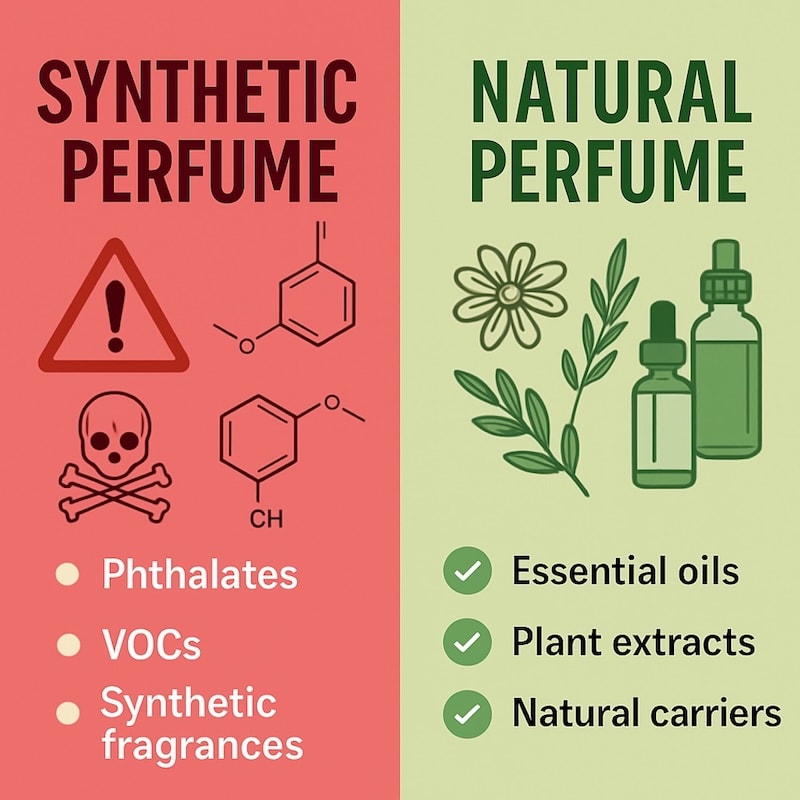
But here's the good news: You can create beautiful, long-lasting perfumes using only natural ingredients that are safe for your family and kind to the environment. Beyond health benefits, DIY perfume offers creative fulfillment and cost savings. High-end perfumes cost over 100 USD per bottle, while homemade perfume ingredients can create multiple bottles for the same investment.
This comprehensive guide will walk you through everything you need to know about how to make natural perfume at home, from understanding fragrance notes to creating your own signature scent.
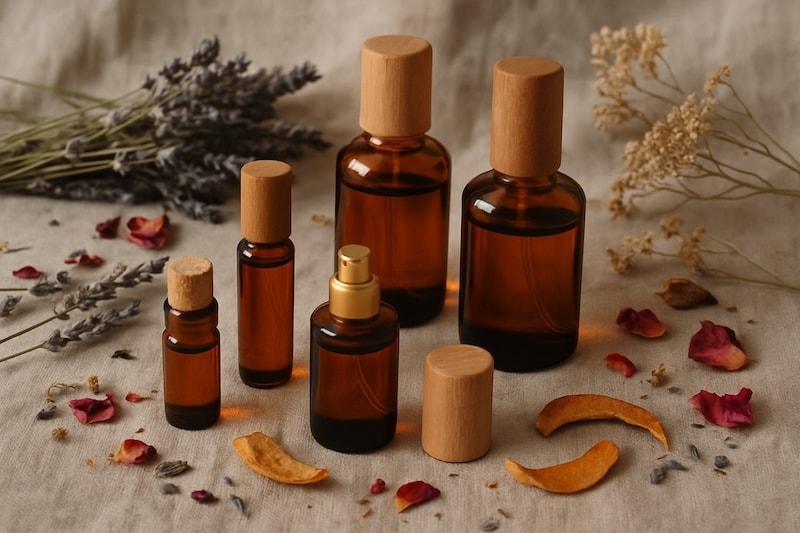
Key Takeaways
-
Conventional perfumes often contain harmful chemicals, including phthalates, which are linked to hormone disruption and reproductive issues.
-
Natural perfume is safer: DIY perfumes use natural ingredients like essential oils, botanical extracts and natural carriers.
-
Simple ingredients create beautiful results: You only need essential oils, high-proof alcohol or carrier oil as base, and basics tools to create professional-quality perfumes at home.
-
Understanding fragrance structure is key: Successful perfumes balance top notes (citrus), middle notes (florals), and base notes (woods) iin a 1:2:1 ratio for harmonious fragrance.
-
Process: Blend essential oils from base to top notes, mix with alcohol or oil, age 48 hours to 6 weeks, then bottle in dark glass.
-
Cost-effective and customizable: Making your own perfume saves money compared to luxury brands while allowing you to create scents perfectly suited to your preferences and sensitivities.
Why Conventional Perfumes Can Be Harmful to Your Health
Let's start with the problem that many of us don't realize we have. Most conventional perfumes—even expensive designer brands—are made with synthetic chemicals that can impact your health and indoor air quality.
The Hidden Chemical Cocktail
That single word "fragrance" on ingredient lists can legally hide nearly 4,000 different chemicals, many of which have never been independently tested for safety. Research by the Natural Resources Defense Council found phthalates in 86% of tested air fresheners and perfumes, despite these chemicals being linked to:
-
Reproductive issues and birth defects
-
Respiratory problems and asthma triggers
-
Allergic reactions and skin sensitivities
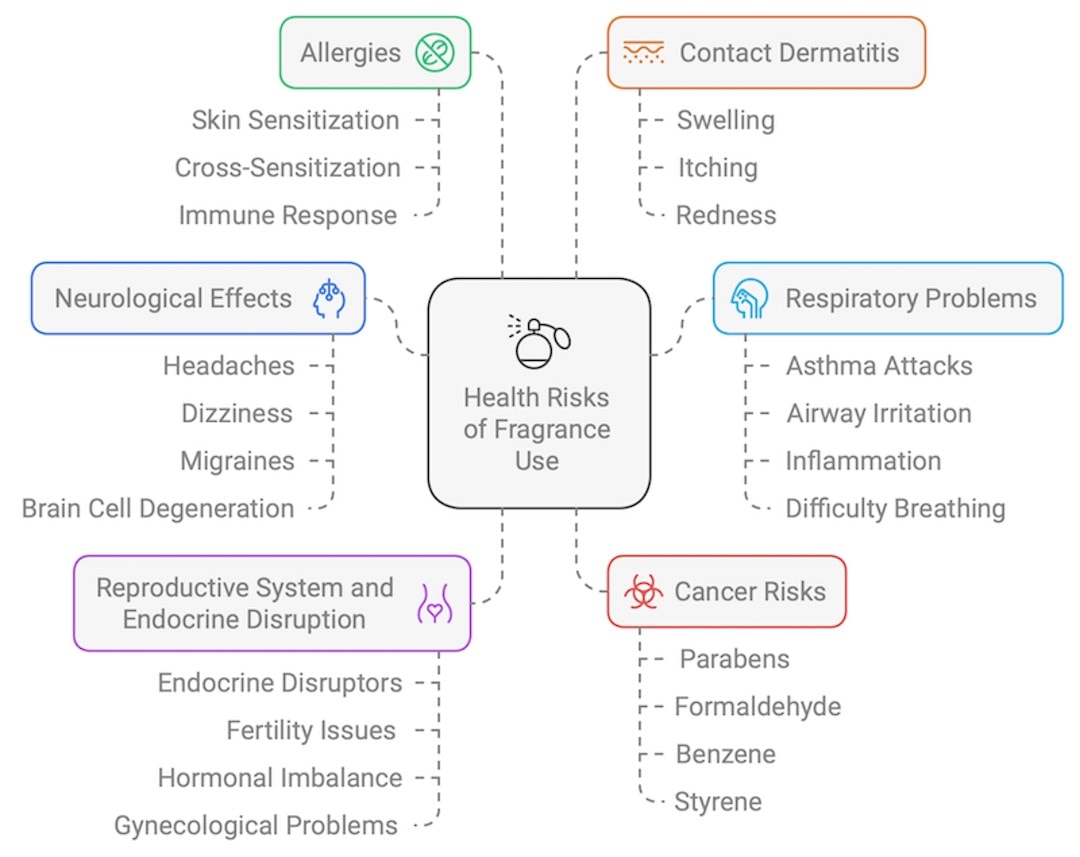
Why This Matters
If you prioritize non-toxic healthy living , you understand the risks and why these hidden chemicals are especially worrisome. Especially children's developing systems are more vulnerable to chemical exposure, also pregnant women need to be especially cautious about endocrine disruptors.
The Natural Alternative
Making your own perfume gives you complete control over ingredients and lets you avoid these toxins while creating a custom scent that reflects your personality, ensuring your fragrance is:
-
Free from synthetic chemicals and phthalates
-
Safe for sensitive skin and allergies
-
Customizable to your exact preferences
-
Environmentally sustainable and cruelty-free
Essential Ingredients for Natural Perfume Making
Creating natural perfume at home requires surprisingly few ingredients, and you can start with a basic kit that costs less than a single bottle of designer perfume.
What ingredients are needed to make perfume?
The following components are essential for making your own homemade perfume.
Essential Oils: The Heart of Your Fragrance
Essential oils are concentrated plant extracts that provide the scent in your natural perfume. Choose high-quality, pure, preferably organic essential oils from reputable suppliers to ensure you're getting the therapeutic benefits without synthetic additives.
Top Notes (20-30% of your blend)
These create the first impression and evaporate quickly (5-15 minutes). Popular choices include:
-
Bergamot: Bright, citrusy, and uplifting
-
Sweet orange: Cheerful and energizing
-
Lemon: Fresh and clean
-
Peppermint: Cooling and invigorating
Middle Notes (50-60% of your blend)
These form the heart of your perfume and last 30-60 minutes. Consider:
-
Lavender: Calming and universally loved
-
Geranium: Floral and balancing
-
Clary sage: Herbaceous and sophisticated
-
Rose: Romantic and luxurious
Base Notes (20-30% of your blend)
These provide longevity and can last several hours. Try:
-
Sandalwood: Creamy and grounding
-
Vetiver: Earthy and complex
-
Vanilla: Sweet and comforting
-
Cedarwood: Woody and warm
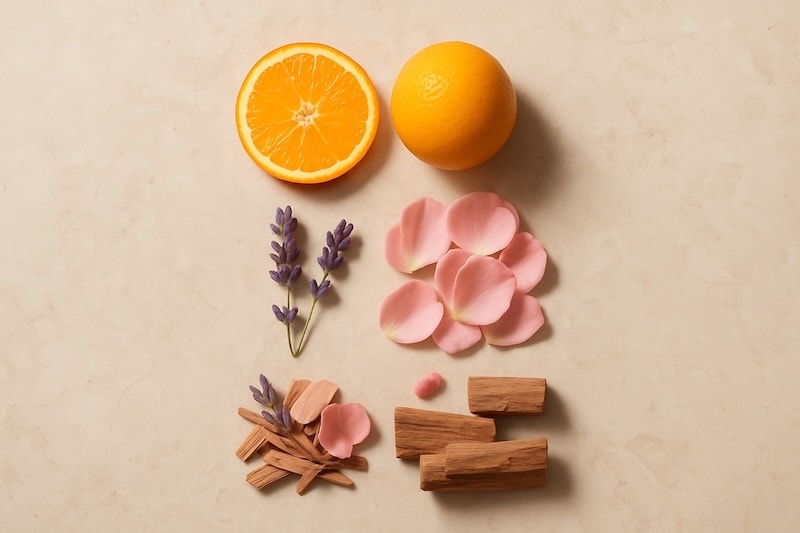
Perfume Base Options
Your carrier dissolves and dilutes the essential oils to create a safe concentration for skin application.
For Alcohol-Based Perfumes: Use high-proof grain alcohol like Everclear (where legal) or quality vodka. Higher alcohol content dissolves oils better and preserves the scent longer.
For Oil-Based Perfumes: Choose lightweight, stable carrier oils:
-
Jojoba oil: Technically a wax, it's incredibly stable and won't go rancid
-
Fractionated coconut oil: Liquid at room temperature and odorless
-
Sweet almond oil: Gentle and suitable for sensitive skin (shorter shelf life)
Essential Tools and Supplies
-
Dark glass bottles: Amber or cobalt blue protect your perfume from light degradation
-
Droppers or pipettes: For precise measuring of essential oils
-
Small funnel: Makes bottling easier and prevents spills
-
Distilled water for dilution
-
Labels and notebook for tracking recipes
Safety tip: Always use glass containers for essential oils, as they can break down plastic over time.
Understanding Fragrance Notes and Fragrance Structure
Creating a well-balanced perfume isn't just about mixing oils you like—it's about understanding how different scents work together and evolve over time on your skin.
The Three-Tier System
Professional perfumers use a three-tier structure that creates a fragrance journey:
Top Notes are your opening act. These volatile molecules evaporate first, creating an immediate impression. Think of them as the friendly greeting that draws people in. Citrus oils excel here because they're naturally bright and uplifting.
Middle Notes are the main performance. These emerge as the top notes fade and represent the core character of your perfume. Floral and herbal oils work beautifully in this space, providing body and personality to your blend.
Base Notes are your lasting impression. These heavy molecules linger for hours, providing depth and helping to "fix" the lighter notes so they last longer on your skin. Woody and resinous oils are perfect for this foundation role.
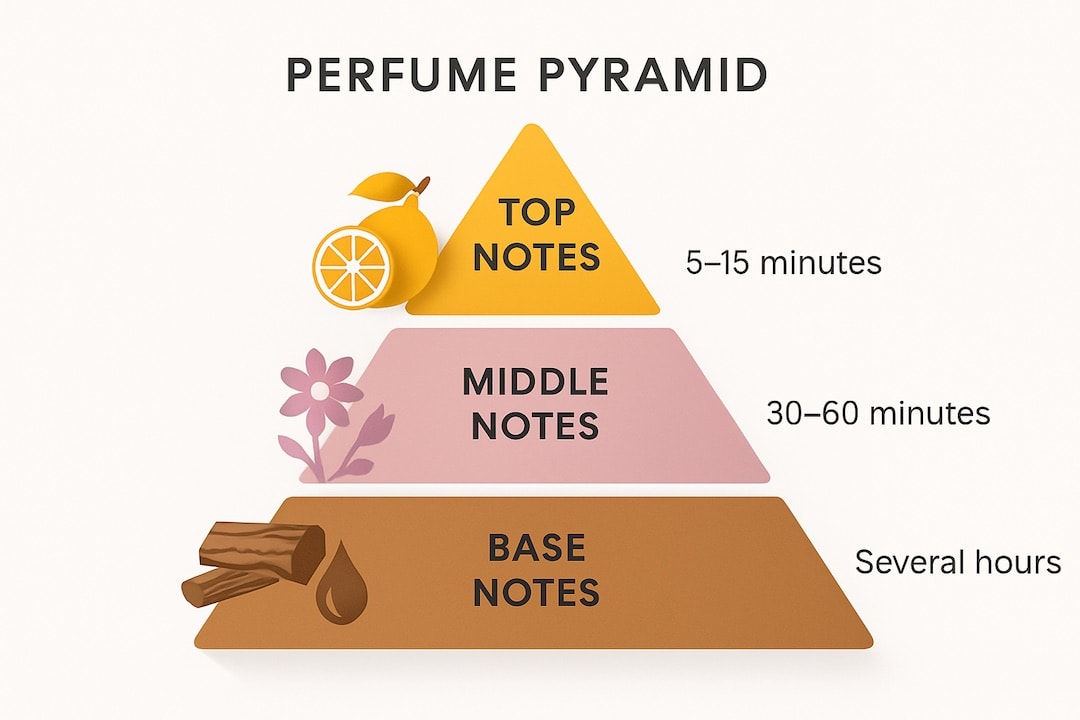
Creating Harmony in Your Blend
The key to a successful natural perfume is balance. A common starting ratio is:
-
2 parts base notes
-
1 part middle notes
-
1 part top notes
For example, in a 20-drop blend:
-
10 drops base notes (sandalwood, vetiver)
-
5 drops middle notes (lavender, geranium)
-
5 drops top notes (bergamot, sweet orange)
Blending Order Matters
Always add your oils in this sequence: base notes first, then middle notes, then top notes. This prevents the volatile top notes from evaporating while you're still blending and allows you to smell how the composition develops.
Step-by-Step Guide: Making Your First Natural Perfume
Ready to create your own non-toxic fragrance? This simple process takes about 30 minutes of active time, plus aging for the best results.
How to make a natural perfume at home?
Step 1: Prepare Your Workspace
Start with a clean, well-ventilated area. Wash all your tools with warm, soapy water and let them dry completely. Having everything organized before you begin makes the process smoother and more enjoyable.
Pro tip: Keep some coffee beans nearby to "reset" your nose between smelling different oils—a trick professional perfumers use.
Step 2: Create Your Essential Oil Blend
Begin with your base notes. For a beginner-friendly blend, try:
-
6 drops sandalwood (creamy, grounding)
-
4 drops vetiver (earthy, sophisticated)
Add your middle notes:
-
4 drops lavender (calming, floral)
-
2 drops geranium (balancing, rosy)
Finish with top notes:
-
6 drops bergamot (bright, citrusy)
-
2 drops sweet orange (cheerful, uplifting)
Gently swirl the mixture and take note of how it smells. This is your concentrated fragrance blend.
Step 3: Add Your Carrier
For a 10ml roller bottle (oil-based perfume): Add your essential oil blend to the bottle, then fill with jojoba oil or fractionated coconut oil. This creates a perfume oil that's perfect for pulse point application.
For a 30ml spray bottle (alcohol-based perfume): Add your essential oil blend, then fill with high-proof alcohol. This creates a traditional spray perfume with good projection.
Step 4: Age Your Perfume
This is the step many beginners skip, but it's crucial for a professional result. Store your perfume in a cool, dark place for at least 48 hours—ideally 2-4 weeks. During this time, the oils will fully integrate and any harsh edges will smooth out.
Step 5: Test and Adjust
After aging, test your perfume on your skin. Natural perfumes often smell different on each person due to individual body chemistry. If you'd like to adjust the scent, make notes for your next batch rather than trying to modify the current one.
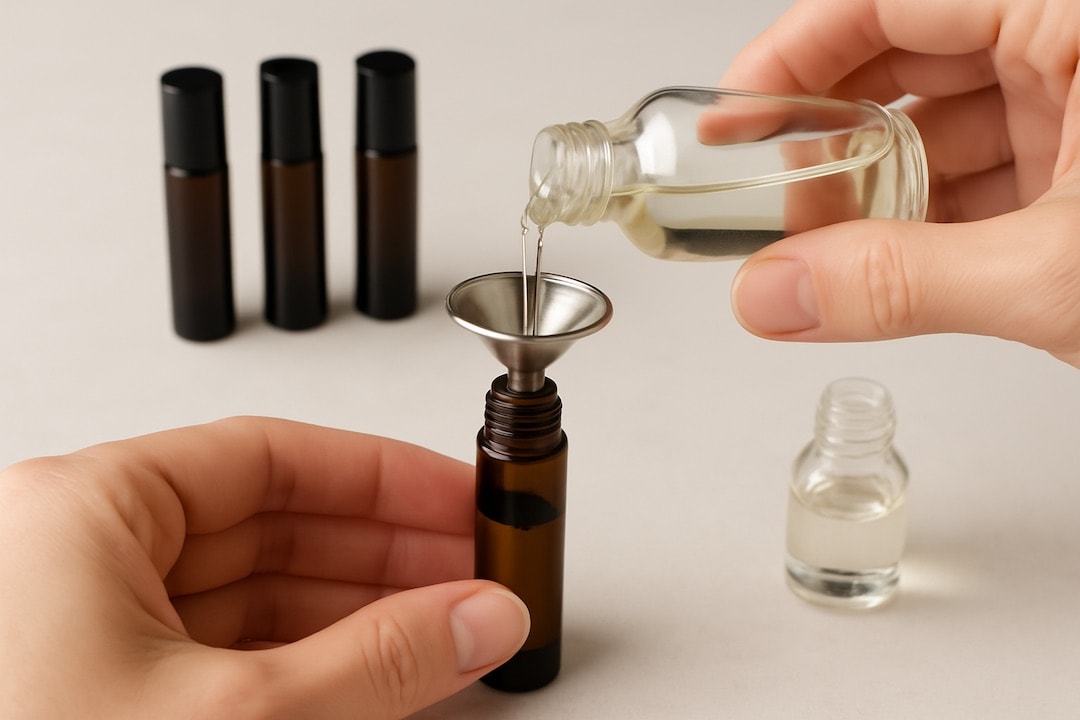
Safety Guidelines for Natural Perfume Making
While natural ingredients are generally safer than synthetic chemicals, it's important to use them responsibly, especially in households with children or during pregnancy.
Essential Oil Safety
Always dilute essential oils: Never apply undiluted essential oils directly to skin. A safe concentration for perfume is typically 15-20% essential oils to 80-85% carrier.
Patch test new blends: Apply a small amount to your inner wrist and wait 24 hours to check for any reactions.
Be aware of photosensitivity: Some citrus oils (bergamot, lemon, lime) can increase sun sensitivity. Avoid sun exposure for 12-24 hours after application.
Pregnancy considerations: Some essential oils should be avoided during pregnancy. When in doubt, consult with a healthcare provider or stick to gentle oils like lavender and sweet orange.
Storage and Shelf Life
Proper storage extends life: Keep your perfumes in dark glass bottles away from heat and direct sunlight.
Know your timelines:
-
Alcohol-based perfumes: 3-5 years
-
Oil-based perfumes: 1-2 years (longer with jojoba oil)
-
Signs of spoilage: Off smells, color changes, or separation
Pet Safety
Some essential oils can be harmful to pets, particularly cats. If you have pets, research pet-safe oils and ensure good ventilation when using your perfumes.
Popular Natural Perfume Recipes for Beginners
Here are three tried-and-tested recipes that work beautifully for different preferences:
Fresh & Clean (Perfect for Daily Wear)
-
Base: 6 drops sandalwood, 2 drops cedarwood
-
Middle: 4 drops lavender, 2 drops geranium
-
Top: 8 drops bergamot, 2 drops lemon
-
Carrier: Jojoba oil or grain alcohol
This blend is fresh without being overwhelming, making it perfect for work or everyday activities.
Warm & Cozy (Ideal for Evening)
-
Base: 5 drops vanilla, 3 drops vetiver, 2 drops black pepper
-
Middle: 4 drops clary sage, 2 drops ylang-ylang
-
Top: 4 drops sweet orange
-
Carrier: Fractionated coconut oil or alcohol
Energizing Citrus (Great for Morning)
-
Base: 6 drops sandalwood, 2 drops patchouli
-
Middle: 4 drops lavender, 2 drops rosemary
-
Top: 8 drops wild orange, 4 drops bergamot
-
Carrier: Jojoba oil or alcohol
Troubleshooting Common Issues
My perfume is too strong: Dilute with more carrier oil or alcohol. Natural perfumes should enhance, not overwhelm.
The scent doesn't last: Add more base notes to your next batch, or try an oil-based carrier for better skin adherence.
It smells different than expected: This is normal! Perfumes smell different when first mixed versus after aging. Give it time to develop.
I'm getting skin irritation: Reduce the essential oil concentration and ensure you're patch testing. Some people are more sensitive than others.
International Trends in Natural Perfumery: Quality Brands for Every Lifestyle
While making your own natural perfume is incredibly rewarding, we understand that not everyone has the time or inclination to become a DIY perfumer. The wonderful news is that the natural fragrance industry has evolved dramatically, offering an abundance of high-quality, non-toxic perfume brands that align perfectly with your health-conscious values.
Many are certified organic, use sustainable sourcing practices, and avoid all the harmful chemicals like phthalates, synthetic musks, and petroleum-derived ingredients.
What Makes a Natural Perfume Brand Trustworthy
When choosing a natural perfume brand, look for these key indicators of quality and safety:
-
Complete Ingredient Transparency: The best brands list every single ingredient, often with explanations of their source and purpose. You should never see just "fragrance" or "parfum" on a truly natural perfume.
-
Organic Certifications: Look for USDA Organic, COSMOS Organic, or similar certifications that ensure ingredients are grown without synthetic pesticides and processed without harmful chemicals.
-
Third-Party Testing: Reputable brands often have their products tested by independent laboratories for purity and safety, especially important for those with sensitive skin or allergies.
-
Sustainable Sourcing: Many leading natural perfume brands work directly with farmers and distilleries, ensuring fair trade practices and environmental responsibility.
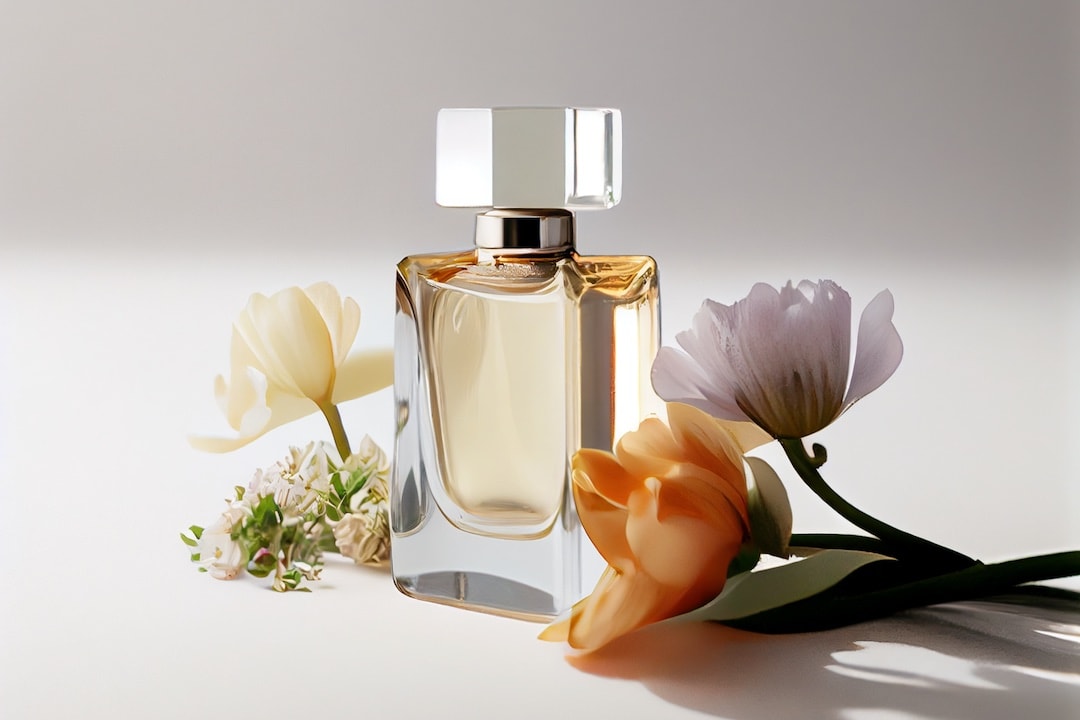
Conclusion: Your Journey to Non-Toxic Fragrance
The beauty of today's natural perfume landscape is that you don't have to choose between DIY and commercial options. Many people find that a combination approach works best:
-
Keep a few trusted natural perfume brands for daily wear and special occasions
-
Make your own seasonal blends or experimental scents
-
Use DIY perfumes for specific aromatherapy needs
-
Gift homemade perfumes to close friends and family while purchasing from brands for acquaintances
This balanced approach gives you the best of both worlds: the creativity and customization of DIY perfumery combined with the convenience and sophistication of professionally crafted natural fragrances.
The natural perfume industry's growth means you have more choices than ever for safe, beautiful fragrances that align with your values. Whether you choose to make your own, purchase from trusted brands, or enjoy both approaches, you're making a positive choice for your health and the environment.
Frequently Asked Questions
How long does homemade perfume last?
Alcohol-based natural perfumes can last 3-5 years when stored properly, while oil-based perfumes typically last 1-2 years. Jojoba oil-based perfumes last the longest due to jojoba's exceptional stability.
Can perfume be made without chemicals?
Technically, all perfumes contain chemicals since everything in nature is composed of chemical compounds. However, perfumes can be made using only natural chemicals derived from plants rather than synthetic ones. True organic or natural perfumes are made exclusively from botanical sources like essential oils, plant extracts, absolutes obtained through physical processes, and organic alcohols sourced from plants like wheat. These natural perfumes avoid synthetic additives, phthalates, parabens, formaldehyde, and artificial musks that are commonly found in conventional fragrances.
How to make fragrance spray with fragrance oil?
To make fragrance spray with fragrance oil, you'll need perfumer's alcohol (or SDA-40-B) and your chosen fragrance oil. Mix approximately 80% alcohol to 20% fragrance oil for a standard eau de parfum concentration. Add the fragrance oil to a glass mixing container first, then slowly add the alcohol while stirring gently. Pour the mixture into a spray bottle with an atomizer and let it mature for 48 hours to 6 weeks for the best scent development. For fragrance oils that contain carrier oils, you may need to shake the bottle before each use as separation can occur.
Can I use essential oils as perfume?
Yes, essential oils can be used as perfume, but they must be properly diluted with a carrier oil or alcohol for skin safety. Never apply undiluted essential oils directly to skin as they can cause irritation, allergic reactions, or sensitivity. For oil-based perfumes, dilute to approximately 15-20% essential oil concentration with carrier oils like jojoba, sweet almond, or fractionated coconut oil.
Why doesn't my natural perfume last as long as store-bought ones?
Commercial perfumes often contain synthetic fixatives and chemicals designed to last longer. Natural perfumes have a softer scent throw but can be reapplied safely throughout the day.
What's the best carrier oil for sensitive skin?
Jojoba oil is excellent for sensitive skin because it's technically a wax and closely mimics your skin's natural sebum. Fractionated coconut oil is also very gentle and unlikely to cause reactions.
Looking for more ways to create a non-toxic home? Explore our guides on natural home scents, non-toxic hand creams, and sustainable fashion choices. Your journey to healthier living starts with small, intentional choices—and making your own natural perfume is a beautiful place to begin.
1 comment
First off thank you for this incredible info. My question I’d: can I use the same amounts for home made cologne alcohol base) to add to Jojoba Oil, Coconut or Caster Oil for a direct skin application (like a body lotion application)?
I sure hope I articulated my question so it is understandable.
Thanks again for sharing.













